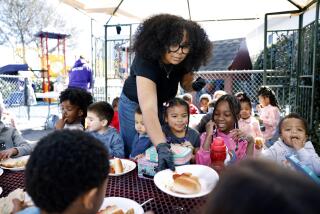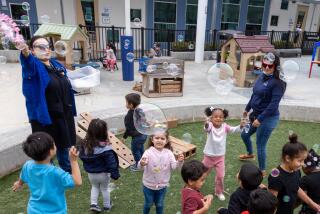COLUMN ONE : Natasha Learns to Be Herself : For the first time in 70 years, Soviet preschools have put stress on individuality instead of conforming to the group.
- Share via
MOSCOW — As the old turntable played a pre-revolutionary Russian folk song at Preschool No. 804, 5-year-old Natasha was doing something that once would have been strictly forbidden in a Soviet classroom. She wasn’t dancing.
Because she felt shy, Natasha was allowed to watch quietly as her classmates spun and twirled. Just a few years ago, her teacher would have been severely rebuked by Soviet school inspectors for allowing a child to sit out a communal activity for even a few moments during the average 12 hours per day of preschool.
As the first formal contact between the child and the state, the country’s nursery schools and kindergartens were long viewed as the place where the initial lessons of Communist collectivism were to be indelibly imprinted. From the shared playpen on, learning to be a member of a homogeneous community was the ideal.
But for the first time in 70 years here, the accent in preschool is on individualism, which can at last be recognized--even appreciated and developed--thanks to perestroika, President Mikhail S. Gorbachev’s program to socially and economically redefine Soviet society.
Preschool No. 804 and a second school selected by the Ministry of Education for a reporter to visit seem without doubt to be model examples of the new thinking.
In many kindergartens in the Soviet Union, you can still find row upon row of identically drawn pictures of flowers or fruit taped to classroom walls--the first introduction to the philosophy of Socialist Realism in art--and some parents complain their children are permitted to go to the bathroom only with the group at scheduled times.
The once-obligatory picture of Soviet founder V. I. Lenin still hangs at kindergartener-eye level in many classrooms.
Nevertheless, the impact of perestroika on preschools is enormous and will have a lasting effect on Soviet society, educators here say.
“Because of the move toward valuing individuals, our human bouquet will be richer, more varied. People will have a chance to reach their full potential, and they will be more confident in questioning authority,” said Leontiva M. Fydorovna, director of a Moscow pedagogical college that educates the preschool teachers of tomorrow.
With the new stress on individuality, she added, “a return to a dictatorship like the one that existed under (Josef) Stalin grows far less likely.”
Soviet preschools, which are generally combined day care, nursery schools and kindergartens, enroll children from the age of 6 months up to 6 years. The preschools play such a key role in the Soviet Union’s future because they are widely attended in this country, where most new mothers return quickly to work.
In Moscow, for example, about 70% of the city’s children attend preschool--about half a million children in 2,760 schools, according to city officials.
The reason for the high enrollment is largely financial. Although maternity benefits were increased recently to two years with a token payment of 35 rubles per month ($56 at the official exchange rate), most families say they still cannot afford more than a year of maternity leave.
So in their most highly impressionable years, Soviet children are generally a captive audience for the lessons the state wants to teach.
In Natasha’s music class, those lessons clearly reflect modern times here.
The spirited tune to which the children were learning to bow and dip, for instance, would have been forbidden in Soviet classrooms before 1985 because it was a Russian song popular among nobility before the 1917 Bolshevik Revolution, music teacher Alla S. Avakovya said.
Another relative innovation: to help the preschoolers settle down, Avakovya put a classical record on the phonograph, turned off the lights, flipped on blinking colored lights and asked the children to think about nature.
The music, lights and call on imagination represent a giant step forward here, Avakovya said.
“Before, we followed absolutely strict methods,” she recalled after the lesson. “For instance, the inspector told me once that the children must always be seated while singing, never standing. Such a light show would have gotten me into big trouble. But now we even get to listen to rock ‘n’ roll.”
Across town in Preschool No. 1144, 5- and 6-year-olds were enjoying more variety in physical education class because of perestroika. Previously, the state suggested about 10 different exercises that the children did over and over all year, “no matter how bored the children and the teacher got,” recalled Irina Y. Zvereva, the school’s director.
Now the teachers can switch exercises at will--and even make up their own. On this day, the children, dressed in black body suits, were trying with varying degrees of success to bend and twist their bodies in time to piano accompaniment. They then bounced and tossed plastic balls.
“They can use the balls every day if they want. Before, the state mandated just once a week,” Zvereva said.
Later the same class was instructed to make clay birds. Most of the birds had multicolored feathers and looked much the same. But one, made by 5-year-old Kostya, stood out--it was polka-dotted.
“Look at this, children,” said the teacher, holding it aloft. “Isn’t it lovely and original?”
Zvereva said that five years ago, teachers at Preschool No. 1144 treated children “just like little soldiers. All together they went to eat, to wash their hands, to go to sleep.”
“The passive children were easily overlooked, all but forgotten. And the teachers themselves were afraid to vary even slightly from all the regulations we got,” she said. “Now we are trying to appreciate each individual.”
Other changes:
- Desks no longer have to be lined up neatly in straight rows. Sometimes they are arranged in circles or small groups. And some classrooms even have couches where children are allowed to lounge during story time.
- There is less emphasis on sitting straight, keeping elbows off tables or standing when a teacher enters the room. “We are trying to teach our student-teachers the importance of being warm, and we have even introduced the concept of children’s rights, which was greeted with great surprise,” said Nina Volkava, a teacher at the pedagogical college for 13 years.
- There is even very tentative, discussion of religion, once the big taboo. “We can talk about religion as history now, not simply in the context of atheism. But about the concept of God, no--that is still off limits,” said Lydia Solnishniya, the director of Preschool No. 804.
Fydorovna, director of the pedagogical school, said that now the focus is on trying to understand a child’s behavior instead of simply molding it. “It’s harder for the teachers. It was simpler just to give a single command to everyone,” she noted. “But in the long run, we believe, it makes the children calmer, easier to handle.”
Not that there are no complaints about the Gorbachev era. The primary one is that schools are suffering from the same shortages that have afflicted most of the rest of Soviet society.
At Preschool No. 804, teachers make or collect most of the toys, which are primarily brightly colored paper shapes, collages, knitted objects and even empty soap boxes and shampoo bottles. At other schools, some parents complain that teachers limit the amount of time children can play with toys to cut down on the chance of the scarce playthings being lost or broken.
College instructor Volkava said the shortages affect the child from an early age. “If you have the feeling that someone can take the only toy you have, then you learn to protect yourself, not to share,” she said.
Another major gripe among educators is that the pay for preschool teachers is so low that it fails to attract the best instructors and leads to chronic teacher shortages.
Starting salary for a beginning preschool teacher who has graduated from an institute is 130 rubles a month ($208). The average Soviet salary is about 250 rubles a month ($400).
Nevertheless, the teachers seem generally happy, educators say.
“Before perestroika, it was not only the children’s creativity that was limited. It was also the teachers,’ ” said preschool director Solnishniya. “The work may be harder, but it is also more interesting.”
The children themselves have a sense that things are different, even if they aren’t quite sure what. Six-year-old Andrei, a sandy-haired boy playing outside Preschool No. 804, had just a hint of uncertainty in his voice as he told a visitor what perestroika meant.
“It is going to help us turn our bad life into a good one,” he said.
More to Read
Sign up for Essential California
The most important California stories and recommendations in your inbox every morning.
You may occasionally receive promotional content from the Los Angeles Times.













